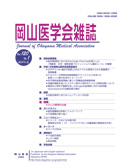

Journal of Okayama Medical Association
Published by Okayama Medical Association<Availability>
Full-text articles are available 3 years after publication.
Permalink : http://escholarship.lib.okayama-u.ac.jp/45011
About the Epidemic of a Kind of Feveric Jaundice occurred in some Parts of Okayama City during the later Summer 1935
Murakami, S.
Miki, Y.
Abe, T.
Published Date
1937-03-31
Abstract
There occurred an epidemic of a kind of feveric jaundice in some parts of Okayama City and its vicinity from the later part of Summer till early autumn 1935. As we had never learned such an outbreak of such an epidemic in these districts, we wished to make it clear. We have studied it under the guidance of Prof. M. Suzuki and our study as a whole resulted as follows: 1) To our regret, we could not succeed in isolating the causal agent. This may be we think, for when we set about the study, the epidemic had already come to its closing period. 2) The clinical symptoms of this disease, we observed, were quite identical with those of the Sakushu fever. 3) And as the serological tests we examined the Pfeiffers phenomenon test and the agglomeration reaction on 12 cases and obtained: 7 positive reaction with Akiyami repto. type A. 3 positive reaction with Akiyami repto. type B. these 10 negative reaction with repto. ict. haemorrha. and the rest 2 of 12 cases gave negative reaction with any of these reptospiras. 4) We cannot yet dare to describe clearly from the epidemiological point of view why such a prevalence of this disease broke out in 1935, but it might be regarded as remarkable facts to indicate some relationship between the great inundation and the epidemic that the infected locality was visited by a disastrous inundation in the preceding year, that the upper course district of the flooded river Asahi was known as the region influenced by the Sakushu fever, and that the infected parts of Okayama City borders the suburbs where a great number of the rats, regarded as the mediators of the Sakushu fever are living, etc.
You will have still more reports after our further study in the future.
ISSN
0030-1558
NCID
AN00032489
